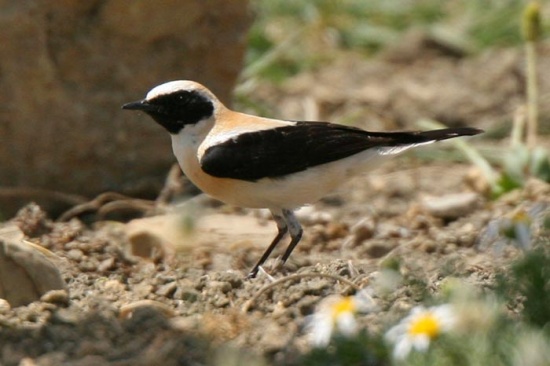(Video link) |
(Video category) |
||
| Line 39: | Line 39: | ||
<br /> | <br /> | ||
{{Video|Black-eared_Wheatear}} | {{Video|Black-eared_Wheatear}} | ||
| − | [[Category:Birds]] [[Category:Oenanthe]] | + | [[Category:Birds]] [[Category:Oenanthe]] [[Category:Videos]] |
Revision as of 18:15, 15 June 2010
- Oenanthe hispanica
Inlcudes Western and Eastern Black-eared Wheatear
Identification
13.5-15.5 cm.
Male - white forehead and crown, buff mantle, black wings, underparts are white tinged with buff, white back, upper tail coverts and tail, black ear coverts, black line from the bill, sometimes black throat.
In autumn and winter the head and mantle are distinctly buff, as are the underparts, including the throat, but the buff varies in intensity.
Males of the eastern race (as seen in Cyprus, for example) are much paler above than the western form. They can look almost black and white in strong sunlight, with just a pale sandy brown colouration.
Also, males of both the eastern and western forms come in two colour morphs - pale throated and black throated. The black throated form is said to be commoner in the eastern subspecies and the white-throated in the western subspecies.
Female - browner bird, and her seasonal changes are less marked.
Similar Species
Identification of younger birds of this species versus Pied Wheatear is discussed in a [thread] in the Identification forum.
Distribution
The "western" subspecies hispanica is found from southern Europe and northern Africa to Senegal and Mali.
"Eastern Black-eared Wheatear" (subspecies melanoleuca) is found in south-east Europe to Iran and the Caspian Sea, migrating to northern Africa.
Taxonomy
Subspecies[1]
Two subspecies are recognized:
- O. h. hispanica in south-western Europe and North Africa
- O. h. melanoleuca in SE Europe, Turkey and to Iran.
Some authorities propose to give full species status to both, named Western Black-eared Wheatear and Eastern Black-eared Wheatear.
Habitat
Stony mountainous slopes, usually below 600 m; open countryside, maybe with a few trees.
Behaviour
Diet
The diet includes insects.
Breeding
Nests in holes among rocks and walls, or under tussocks of grass.
References
- Clements, JF. 2009. The Clements Checklist of Birds of the World. 6th ed., with updates to December 2009. Ithaca: Cornell Univ. Press. ISBN 978-0801445019.
- Collins Field Guide 5th Edition
- Collins Bird Guide ISBN 0 00 219728 6
Recommended Citation
- BirdForum Opus contributors. (2024) Western Black-eared Wheatear. In: BirdForum, the forum for wild birds and birding. Retrieved 2 May 2024 from https://www.birdforum.net/opus/Western_Black-eared_Wheatear
External Links





